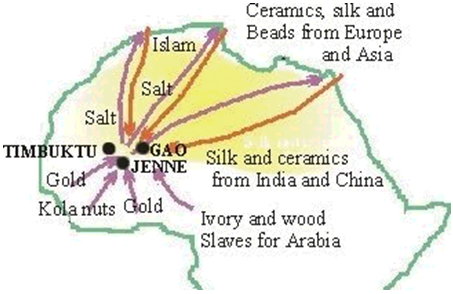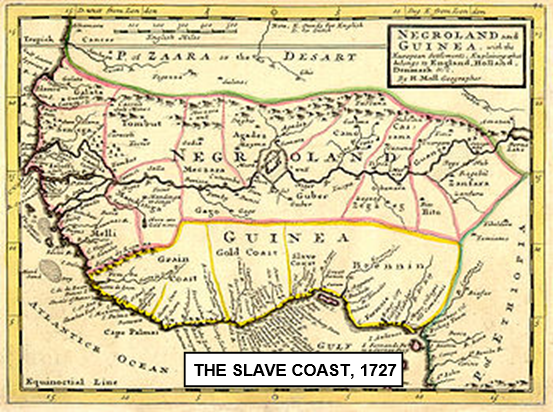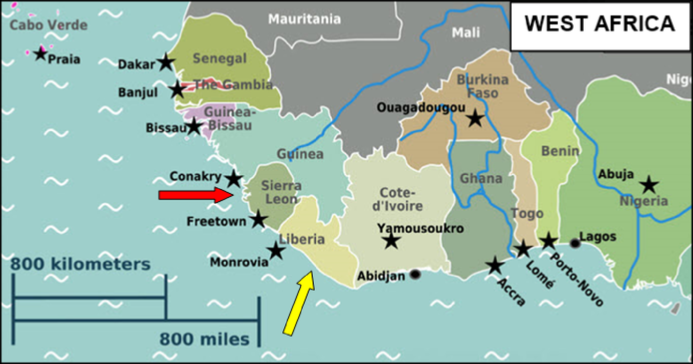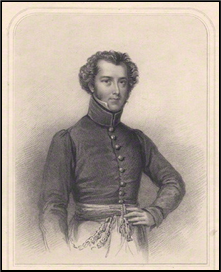


xxxxxAs we have seen, the Songhai Empire, the last great empire of West Africa, was defeated by the Moroccans at the Battle of Tondibi in 1591 (L1). And by this time the Portuguese had explored the coast of this area, had set up forts, and were trading with the natives in gold, silk and ivory. They were soon followed by the Dutch and then other European merchants, attracted not only by the prospect of gold, but also by the fortunes to be made in the slave trade. This had started as a trickle but, with the discovery of the New World and the beginning of the plantation system, had quickly turned into a flood. Along the “Slave Coast” three empires emerged -
WEST AFRICA AND THE START OF COLONIALISM 1821 (G4)
Acknowledgements
Map (West Africa): http://africanhistory.about.com/od/kingdoms/ss/SaharaTradeRoutes. Map (Slave Coast): licensed under Creative Commons – en.wikipedia.org. Produced by the Dutch (?) cartographer and engraver Herman Moll (1654-
 xxxxxDespite the hostile conditions, a thriving trade flourished across the Sahara desert in West Africa for hundreds of years. Large camel caravans -
xxxxxDespite the hostile conditions, a thriving trade flourished across the Sahara desert in West Africa for hundreds of years. Large camel caravans -
xxxxxAnd by this time, Europeans were also making their presence felt, though confined to the coast. As we have seen, under the initial inspiration and direction of Henry the Navigator, son of King John I of Portugal, the entire western coast of Africa had been explored by the end of the 15th century, and Vasco da Gama had rounded the Cape and reached India. As they went, the Portuguese established a string of forts and trading stations along the Guinea coast of West Africa, and from here they traded in alluvial gold, ivory and spices. For a while they enjoyed a trade monopoly, but eventually other countries followed in their wake. The Dutch were the first to arrive. They virtually took over from the Portuguese, but their success did not go unnoticed. Soon merchants were arriving from France, Britain and Scandinavia, trading as companies or solo adventurers. At first, they were mainly lured by the talk of “hills of gold” in Bambuk, and the fabled wealth of Timbuktu and other trading centres, but soon another “commodity” came to rival all others in the money stakes -
 xxxxxFrom the earliest times, slaves had been taken across the Sahara to serve as servants, soldiers or concubines in the courts of the Arab and Berber princes. The Portuguese themselves had begun a small trade in slaves in the 1450s to supplement their own labour force, but the discovery of America in 1492 was to turn a trickle into a flood. By the early 16th century the demand for labour in the New World -
xxxxxFrom the earliest times, slaves had been taken across the Sahara to serve as servants, soldiers or concubines in the courts of the Arab and Berber princes. The Portuguese themselves had begun a small trade in slaves in the 1450s to supplement their own labour force, but the discovery of America in 1492 was to turn a trickle into a flood. By the early 16th century the demand for labour in the New World -
xxxxxAs one can imagine, the bitter competition that arose between the European traders and their African providers brought turmoil throughout West Africa, especially with the collapse of the vast Songhai Empire in 1591. In the interior, states like the Hausa and Mossi seized the chance to expand, whilst on the Slave Coast itself (along the Gulf of Guinea) three powerful slave empires emerged and fought throughout the 18th century to gain predominance -
 xxxxxIt was many years before this trans-
xxxxxIt was many years before this trans-
XXXXXXXXXXXXXXXXXXXXXXXXXXXXXXXXXXXXXXXXXXXXXXXXX
xxxxxLikewise the area known as Liberia (arrowed on map above) was purchased by the American Colonisation Society as a refuge for black slaves liberated in the southern states of the USA. The first settlers arrived in 1820, and four years later their settlement was named Monrovia (after the US president James Monroe). As the number of colonist increased, however, it took on the name of Liberia, and in 1847 became the first republic in Black Africa to gain its independence.
xxxxxBy the beginning of the 19th century, Britain and France -
 xxxxxIncidentally, serving with the British army in Sierra Leone and taking part in the First Anglo-
xxxxxIncidentally, serving with the British army in Sierra Leone and taking part in the First Anglo-
xxxxx…… An earlier attempt to make Sierra Leone a settlement for freed slaves was made by opponents of the slave trade in 1787. Aimed at resettling former slaves who had come to London, it was not enthusiastically received. Eventually up to 350 sailed to Sierra Leone, but within four years only some sixty had survived the primitive conditions and the local fighting. However, these were joined by some 2000 freed slaves from Nova Scotia and Jamaica and, as we have seen, in 1808 the British government took over the colony from the Sierra Leone Company and gave official backing to the scheme. ……
xxxxx…… During the forty year period 1825-
xxxxx…… As we shall see, in 1824 an attack by the Ashanti Empire upon their neighbour the Fonti involved the British, and led to the First Anglo-
Including:
Liberia, and
Sierra Leone

G4-


